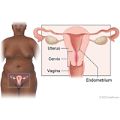Our Health Library information does not replace the advice of a doctor. Please be advised that this information is made available to assist our patients to learn more about their health. Our providers may not see and/or treat all topics found herein. An endometrial biopsy is a way for your doctor to take a small sample of the lining of the uterus (endometrium). The sample is looked at under a microscope for abnormal cells. An endometrial biopsy helps your doctor find problems in the endometrium. An endometrial biopsy is sometimes done at the same time as another test, called hysteroscopy, which allows your doctor to look through a small lighted tube at the lining of the uterus. An endometrial biopsy is done to check for abnormal cells in the lining of the uterus (endometrium). It checks for precancerous and cancerous cells. It may be done if you are at higher risk for uterine cancer or have symptoms of uterine cancer, such as abnormal bleeding from your uterus. The biopsy can be done in your doctor's office. You may be told to empty your bladder just before the test. You will need to take off your clothes below the waist. You will be given a covering to drape around your waist. You will then lie on your back on an examination table with your feet and legs supported by footrests. Your doctor may do a bimanual pelvic exam first. This is done so the doctor can feel where and how large the pelvic organs are. Then the doctor will place a tool called a speculum into your vagina. It opens the vagina a little bit so your doctor can see the cervix and inside the vagina. Your cervix may be numbed with a spray or injection of local anesthetic. The tube to collect the sample is guided through the cervix into the uterus. The tool may be moved up and down to collect the sample. The test will take about 5 to 15 minutes. You may feel cramping as the tube is guided through your cervix and when the biopsy sample is collected. It may feel like a menstrual cramp. There is a small chance that the cervix or uterus could be punctured during the biopsy. Bleeding or a pelvic infection is also possible. Lab results from a biopsy may take several days to get back. Normal: No abnormal cells or cancer is found. Abnormal: A noncancerous (benign) growth, called a polyp, is present. Overgrowth of the lining of the uterus (endometrial hyperplasia) is present. Cancer or cell changes that may lead to cancer are present. Current as of: May 5, 2025 Author: Ignite Healthwise, LLC Staff Current as of: May 5, 2025 Author: Ignite Healthwise, LLC Staff Clinical Review Board This information does not replace the advice of a doctor. Ignite Healthwise, LLC disclaims any warranty or liability for your use of this information. Your use of this information means that you agree to the Terms of Use and Privacy Policy. Learn how we develop our content. To learn more about Ignite Healthwise, LLC, visit webmdignite.com. © 2024-2025 Ignite Healthwise, LLC.Endometrial Biopsy
Test Overview
Why It Is Done
How To Prepare
How It Is Done
How long the test takes
How It Feels
Risks
Results
Related Information
Credits
Clinical Review Board
All Ignite Healthwise, LLC education is reviewed by a team that includes physicians, nurses, advanced practitioners, registered dieticians, and other healthcare professionals.
All Ignite Healthwise, LLC education is reviewed by a team that includes physicians, nurses, advanced practitioners, registered dieticians, and other healthcare professionals.
Our Health Library information does not replace the advice of a doctor. Please be advised that this information is made available to assist our patients to learn more about their health. Our providers may not see and/or treat all topics found herein. Current as of: May 5, 2025 Author: Ignite Healthwise, LLC Staff Clinical Review BoardEndometrial Biopsy
All Ignite Healthwise, LLC education is reviewed by a team that includes physicians, nurses, advanced practitioners, registered dieticians, and other healthcare professionals.




